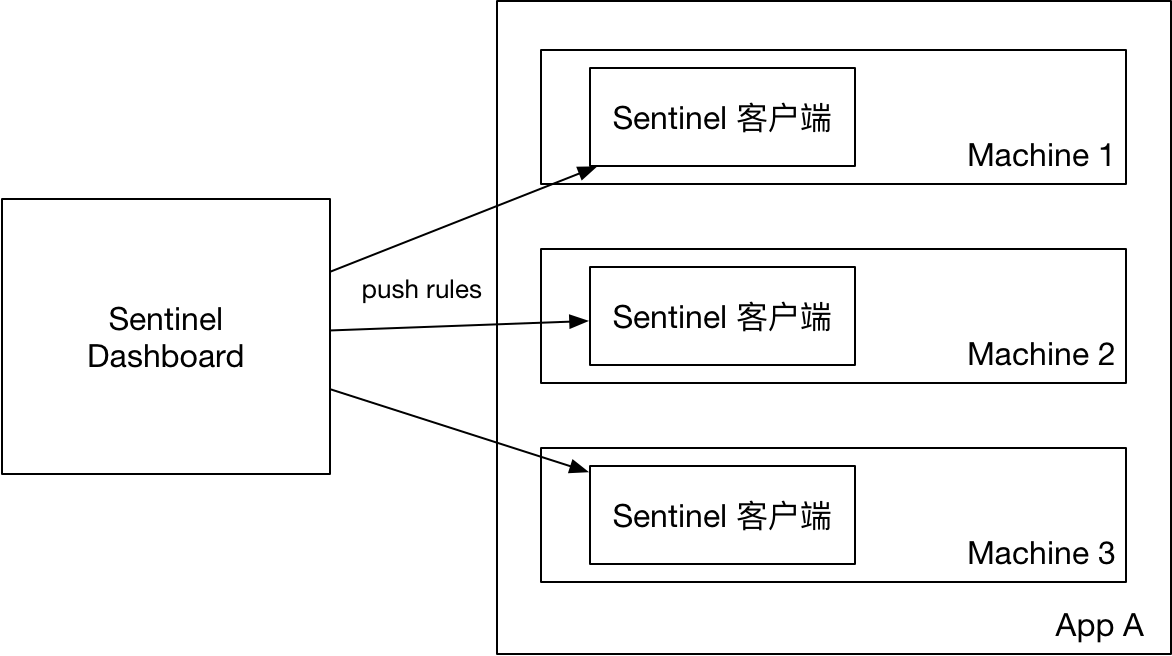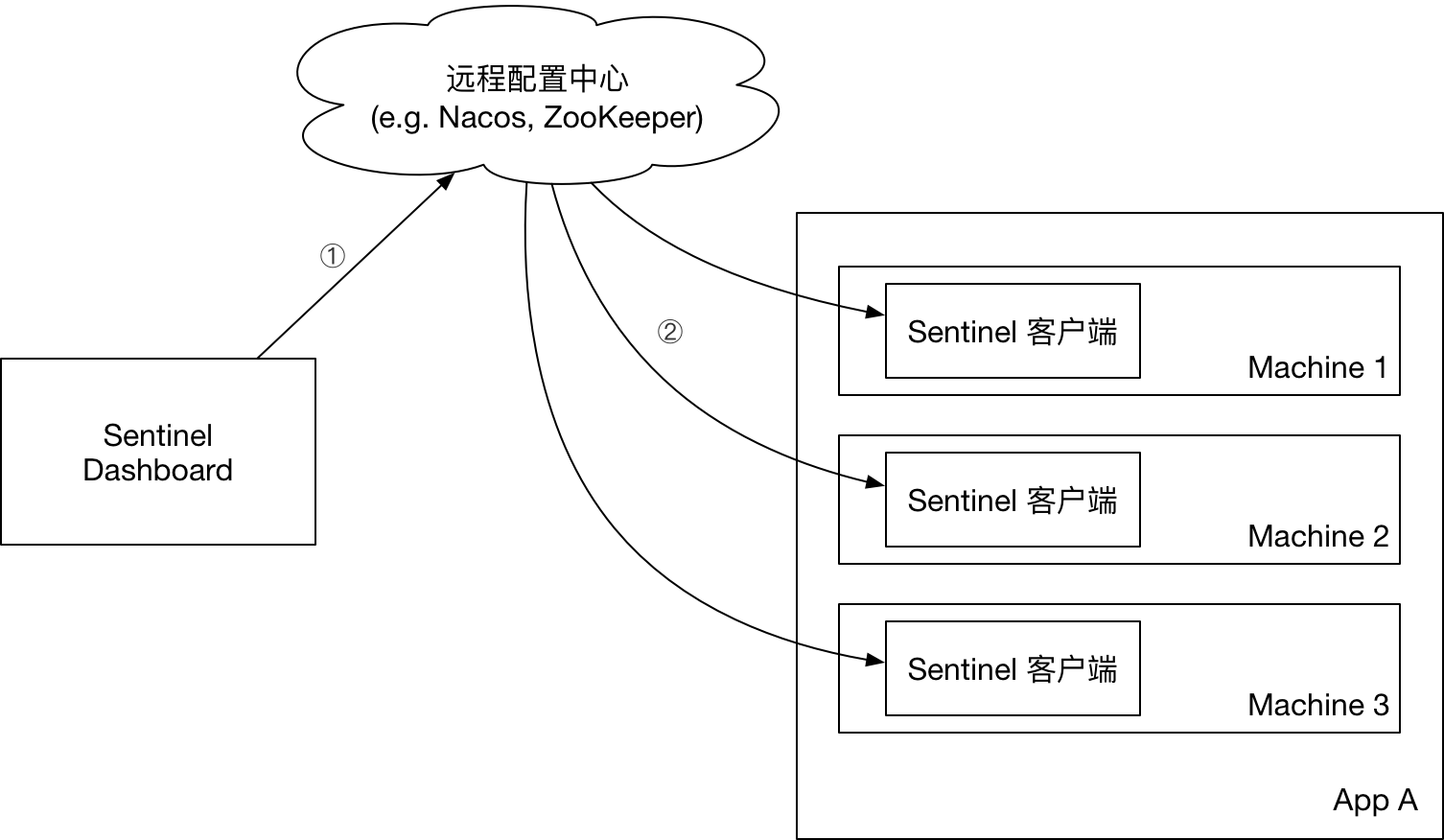SpringCloud入门实战(10)--Sentinel(2)--规则持久化
在Sentinel控制台中配置的规则,默认是保存在内存中的,重启后就会丢失;本文主要介绍规则的持久化,文中使用到的软件版本:Sentinel 1.3.2、Spring Boot 2.2.5.RELEASE、Spring Cloud Hoxton.SR3、Java 1.8.0_191。
1、规则管理及推送
| 推送模式 | 说明 | 优点 | 缺点 |
|---|---|---|---|
| 原始模式 | API 将规则推送至客户端并直接更新到内存中,扩展写数据源(WritableDataSource) |
简单,无任何依赖 | 不保证一致性;规则保存在内存中,重启即消失。严重不建议用于生产环境 |
| Pull 模式 | 扩展写数据源(WritableDataSource), 客户端主动向某个规则管理中心定期轮询拉取规则,这个规则中心可以是 RDBMS、文件 等 |
简单,无任何依赖;规则持久化 | 不保证一致性;实时性不保证,拉取过于频繁也可能会有性能问题。 |
| Push 模式 | 扩展读数据源(ReadableDataSource),规则中心统一推送,客户端通过注册监听器的方式时刻监听变化,比如使用 Nacos、Zookeeper 等配置中心。这种方式有更好的实时性和一致性保证。生产环境下一般采用 push 模式的数据源。 |
规则持久化;一致性;快速 | 引入第三方依赖 |
1.1、原始模式
如果不做任何修改,Dashboard 的推送规则方式是通过 API 将规则推送至客户端并直接更新到内存中:

这种做法的好处是简单,无依赖;坏处是应用重启规则就会消失,仅用于简单测试,不能用于生产环境。
1.2、Pull模式
pull 模式的数据源(如本地文件、RDBMS 等)一般是可写入的。使用时需要在客户端注册数据源:将对应的读数据源注册至对应的 RuleManager,将写数据源注册至 transport 的 WritableDataSourceRegistry 中。本地文件数据源会定时轮询文件的变更,读取规则。这样我们既可以在应用本地直接修改文件来更新规则,也可以通过 Sentinel 控制台推送规则。以本地文件数据源为例,推送过程如下图所示:

使用 pull 模式的数据源时一般不需要对 Sentinel 控制台进行改造。这种实现方法好处是简单,不引入新的依赖,坏处是无法保证监控数据的一致性。
1.3、Push模式
生产环境下一般更常用的是 push 模式的数据源。对于 push 模式的数据源,如远程配置中心(ZooKeeper, Nacos, Apollo等等),推送的操作不应由 Sentinel 客户端进行,而应该经控制台统一进行管理,直接进行推送,数据源仅负责获取配置中心推送的配置并更新到本地。因此推送规则正确做法应该是 配置中心控制台/Sentinel 控制台 → 配置中心 → Sentinel 数据源 → Sentinel,而不是经 Sentinel 数据源推送至配置中心。

2、规则持久化
2.1、Pull模式持久化
该模式只需要在应用中进行改造,不需要改造sentinel控制台。
2.1.1、引入依赖
<dependency> <groupId>com.alibaba.csp</groupId> <artifactId>sentinel-datasource-extension</artifactId> <version>1.8.0</version> </dependency>
2.1.2、编写持久化类
package com.abc.scdemo.server.sentinel; import com.alibaba.csp.sentinel.command.handler.ModifyParamFlowRulesCommandHandler; import com.alibaba.csp.sentinel.datasource.*; import com.alibaba.csp.sentinel.init.InitFunc; import com.alibaba.csp.sentinel.slots.block.authority.AuthorityRule; import com.alibaba.csp.sentinel.slots.block.authority.AuthorityRuleManager; import com.alibaba.csp.sentinel.slots.block.degrade.DegradeRule; import com.alibaba.csp.sentinel.slots.block.degrade.DegradeRuleManager; import com.alibaba.csp.sentinel.slots.block.flow.FlowRule; import com.alibaba.csp.sentinel.slots.block.flow.FlowRuleManager; import com.alibaba.csp.sentinel.slots.block.flow.param.ParamFlowRule; import com.alibaba.csp.sentinel.slots.block.flow.param.ParamFlowRuleManager; import com.alibaba.csp.sentinel.slots.system.SystemRule; import com.alibaba.csp.sentinel.slots.system.SystemRuleManager; import com.alibaba.csp.sentinel.transport.util.WritableDataSourceRegistry; import com.fasterxml.jackson.core.JsonProcessingException; import com.fasterxml.jackson.core.type.TypeReference; import com.fasterxml.jackson.databind.ObjectMapper; import java.util.List; /** * 文件数据源 */ public class FileDataSourceInitFunc implements InitFunc { private ObjectMapper objectMapper = new ObjectMapper(); /**流控规则对象转换*/ private Converter<String, List<FlowRule>> flowRuleConverter = source -> { try { return objectMapper.readValue(source, new TypeReference<List<FlowRule>>(){}); } catch (JsonProcessingException e) { e.printStackTrace(); } return null; }; /**降级规则对象转换*/ private Converter<String, List<DegradeRule>> degradeRuleConverter = source -> { try { return objectMapper.readValue(source, new TypeReference<List<DegradeRule>>(){}); } catch (JsonProcessingException e) { e.printStackTrace(); } return null; }; /**系统规则对象转换*/ private Converter<String, List<SystemRule>> systemRuleConverter = source -> { try { return objectMapper.readValue(source, new TypeReference<List<SystemRule>>(){}); } catch (JsonProcessingException e) { e.printStackTrace(); } return null; }; /**授权规则对象转换*/ private Converter<String, List<AuthorityRule>> authorityRuleConverter = source -> { try { return objectMapper.readValue(source, new TypeReference<List<AuthorityRule>>(){}); } catch (JsonProcessingException e) { e.printStackTrace(); } return null; }; /**授权规则对象转换*/ private Converter<String, List<ParamFlowRule>> paramFlowRuleConverter = source -> { try { return objectMapper.readValue(source, new TypeReference<List<ParamFlowRule>>(){}); } catch (JsonProcessingException e) { e.printStackTrace(); } return null; }; @Override public void init() throws Exception { String ruleDir = "d:/temp/sentinel/rules"; String flowRulePath = ruleDir + "/flow-rule.json"; String degradeRulePath = ruleDir + "/degrade-rule.json"; String systemRulePath = ruleDir + "/system-rule.json"; String authorityRulePath = ruleDir + "/authority-rule.json"; String paramFlowRulePath = ruleDir + "/param-flow-rule.json"; //流控规则 ReadableDataSource<String, List<FlowRule>> flowRuleRDS = new FileRefreshableDataSource<>(flowRulePath, flowRuleConverter); FlowRuleManager.register2Property(flowRuleRDS.getProperty()); WritableDataSource<List<FlowRule>> flowRuleWDS = new FileWritableDataSource<>(flowRulePath, this::encodeJson); WritableDataSourceRegistry.registerFlowDataSource(flowRuleWDS); //降级规则 ReadableDataSource<String, List<DegradeRule>> degradeRuleRDS = new FileRefreshableDataSource<>(degradeRulePath, degradeRuleConverter); DegradeRuleManager.register2Property(degradeRuleRDS.getProperty()); WritableDataSource<List<DegradeRule>> degradeRuleWDS = new FileWritableDataSource<>(degradeRulePath, this::encodeJson); WritableDataSourceRegistry.registerDegradeDataSource(degradeRuleWDS); //系统规则 ReadableDataSource<String, List<SystemRule>> systemRuleRDS = new FileRefreshableDataSource<>(systemRulePath, systemRuleConverter); SystemRuleManager.register2Property(systemRuleRDS.getProperty()); WritableDataSource<List<SystemRule>> systemRuleWDS = new FileWritableDataSource<>(systemRulePath, this::encodeJson); WritableDataSourceRegistry.registerSystemDataSource(systemRuleWDS); //授权规则 ReadableDataSource<String, List<AuthorityRule>> authorityRuleRDS = new FileRefreshableDataSource<>(flowRulePath, authorityRuleConverter); AuthorityRuleManager.register2Property(authorityRuleRDS.getProperty()); WritableDataSource<List<AuthorityRule>> authorityRuleWDS = new FileWritableDataSource<>(authorityRulePath, this::encodeJson); WritableDataSourceRegistry.registerAuthorityDataSource(authorityRuleWDS); //热点参数规则 ReadableDataSource<String, List<ParamFlowRule>> hotParamFlowRuleRDS = new FileRefreshableDataSource<>(paramFlowRulePath,paramFlowRuleConverter); ParamFlowRuleManager.register2Property(hotParamFlowRuleRDS.getProperty()); WritableDataSource<List<ParamFlowRule>> paramFlowRuleWDS = new FileWritableDataSource<>(paramFlowRulePath,this::encodeJson); ModifyParamFlowRulesCommandHandler.setWritableDataSource(paramFlowRuleWDS); } private <T> String encodeJson(T t) { try { return objectMapper.writeValueAsString(t); } catch (JsonProcessingException e) { e.printStackTrace(); } return null; } }
2.1.3、启用持久化类
资源目录(通常是resource目录)创建META-INF/services目录,并在该目录下创建com.alibaba.csp.sentinel.init.InitFunc文件,内容为:
com.abc.scdemo.server.sentinel.FileDataSourceInitFunc

2.1.3、验证
启动sentinel控制台并启动应用,配置规则后,可以看到生成了对应的文件,文件内容就是规则信息:

2.2、Push模式持久化
该模式需同时改造sentinel控制台和自己的应用。
2.2.1、控制台改造
2.2.1.1、下载sentinel源码
https://github.com/alibaba/Sentinel
2.2.1.2、修改原sentinel-dashboard项目下的POM文件
<dependency> <groupId>com.alibaba.csp</groupId> <artifactId>sentinel-datasource-nacos</artifactId> <!--scope>test</scope--> </dependency>
注释掉scope
2.2.1.3、复制sentinel-dashboard项目下test中的nacos代码
src/test/java/com/alibaba/csp/sentinel/dashboard/rule/nacos到src/main/java/com/alibaba/csp/sentinel/dashboard/rule下

2.2.1.4、修改NacosConfig中的nacos服务地址
com.alibaba.csp.sentinel.dashboard.rule.nacos.NacosConfig:
@Bean public ConfigService nacosConfigService() throws Exception { return ConfigFactory.createConfigService("localhost:8848"); }
2.2.1.5、修改FlowControllerV2中的ruleProvider和rulePublisher
com.alibaba.csp.sentinel.dashboard.controller.v2.FlowControllerV2:
@Autowired @Qualifier("flowRuleDefaultProvider") private DynamicRuleProvider<List<FlowRuleEntity>> ruleProvider; @Autowired @Qualifier("flowRuleDefaultPublisher") private DynamicRulePublisher<List<FlowRuleEntity>> rulePublisher;
改为:
@Autowired @Qualifier("flowRuleNacosProvider") private DynamicRuleProvider<List<FlowRuleEntity>> ruleProvider; @Autowired @Qualifier("flowRuleNacosPublisher") private DynamicRulePublisher<List<FlowRuleEntity>> rulePublisher;
2.2.1.6、sidebar.html流控规则路由从dashboard.flowV1改成dashboard.flow
sentinel-dashboard/src/main/webapp/resources/app/scripts/directives/sidebar/sidebar.html:
<li ui-sref-active="active" ng-if="!entry.isGateway"> <a ui-sref="dashboard.flow({app: entry.app})"> <i class="glyphicon glyphicon-filter"></i> 流控规则</a> </li>
注意:在该页面添加规则与在簇点链路页面添加流控规则不是同一页面,簇点链路页面添加规则需另行改造。
2.2.1.7、其他规则改造
上面的步骤只是改造了流控规则,其他的规则可用参考流控规则进行改造。
2.2.2、应用改造
2.2.2.1、引入依赖
<dependency> <groupId>com.alibaba.csp</groupId> <artifactId>sentinel-datasource-nacos</artifactId> <version>1.8.0</version> </dependency>
2.2.2.2、增加规则数据源配置
spring:
cloud:
sentinel:
transport:
port: 8719
dashboard: 10.49.196.10:8080
datasource:
flow:
nacos:
server-addr: 10.49.196.10:8848
dataId: ${spring.application.name}-flow-rules
groupId: SENTINEL_GROUP
rule-type: flow
degrade:
nacos:
server-addr: 10.49.196.10:8848
dataId: ${spring.application.name}-degrade-rules
groupId: SENTINEL_GROUP
rule-type: degrade
这边只配置了流控及降级的数据源,其他规则类似配置。
2.2.3、验证
启动nacos、sentinel控制台及应用,在sentinel配置规则后,在nacos控制台中可以看到对应的配置,配置内容就是规则信息:


